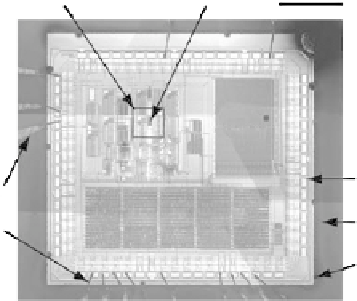Biomedical Engineering Reference
In-Depth Information
SU-8 well
ISFET
1 mm
ADC
memory
analog
circuitry
microchip
PCB track
microcontroller
PCB
bond-wire
recess
FIGURE 10.4
Microphotograph of the pH ISFET with an on-chip pH meter. The whole device was
coated with SU-8 photoresist using standard UV photolithography, leaving a 500 µm square well as the
ISFET opening. (Reproduced from [85], with permission from Elsevier.)
arrangement of ions in response to a specifi c
V
gate is determined by the size and charge
of the ions. By measuring the gate capacitance (
C
gate) vs
V
gate, ion species and con-
centration can be determined [65, 81, 82]. EIS sensors have a response behavior com-
parable to ISFETs due to their common detection principle and common transducer
material. In contrast to ISFETs, the sensitive area of an EIS sensor, in general, is larger
than the gate region of an ISFET, and therefore is less suitable for miniaturization [83].
As a supplement for widely used glass electrodes, ISFET sensors provide some
unique features. One of them is the capability of dry storage, which helps to avoid
the problem of shelf-life and the hydration requirement time for glass electrodes. Fast
response is another feature of an ISFET pH sensor. In a comparison study of com-
mercial pH sensors reported by Smit
et al.
[84], the ISFET sensor showed about a ten
times faster response than that of glass electrodes, and a response similar to that of an
iridium oxide-based electrode [100, 104]. This fast response time of ISFET sensors
was attributed to its sensing mechanism, which is based on the electrostatic interaction
of H
ions with surface charge at the gate surface [66].
A third feature for an ISFET sensor is its capability of miniaturization. Fabrication of
ISFET is mainly based on various CMOS (complementary metal-oxide-semiconductor)
technologies developed for IC manufacturing with some modifi cations for applying gate
materials [79]. This provides the possibility of miniaturization and opens an avenue for
integration of pH ISFET with other sensors as well as measurement circuits. Recently,
Hammond and Cumming [85] reported an ISFET that has an integrated digital pH meter
(Fig. 10.4). The device was fabricated using a commercial CMOS process with a built-
in on-chip drift compensation function. However, the device has a low pH sensitivity of
48 mV/pH. This may be a result of the sensor's unmodifi ed gate, which is limited by the
commercial CMOS process used.






Search WWH ::

Custom Search